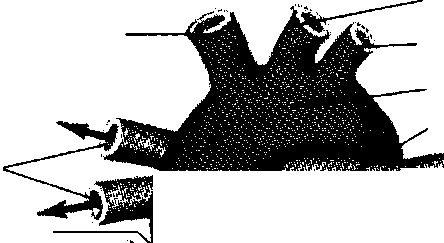Вступний фонетикоорфоепічний курс вступ
 Скачать 25.36 Mb. Скачать 25.36 Mb.
|
|
Exercise 2. Learn the words, pay attention to pronunciation. soul [ssul] душа. E.g. SOS means "save our souls". heart [ha:t] серце. E.g. You took my heart and soul. hollow ['hobo] порожнистий. E.g. The stomach is a hollow organ. beat [bi:t] удар. E.g. You made some beats in the game. heartbeat - биття серця; пульсація time [taim] час; раз. E.g. Do it two times a week. disease [di'zi:z] хвороба. E.g. Heart diseases are dangerous. regular ['regju:b] правильний; постійний contraction [ksnt'rEekJh] скорочення. E.g. Heart contractions were frequent. regimen ['rechrmen] режим; дієта E.g. You must keep your regimen. chamber [tfeimba] камера atrium - передсердя ventricle ['ventrikl] шлуночок artery ['a:tsri] артерія vein [vein] вена capillary [ks'pibri] капіляр blood [bUd] кров vessel ['vesl] судина. E.g. Blood vessels are veins, arteries and capillaries. septum ['septsm] перегородка valve [vaelv] клапан mitral ['maitrel] митральний tricuspid [trai'kAspid] тристулковий circulation [,s3:kju:'leijh] циркуляція. E.g. There are two blood circulations - greater and lesser. Exercise 3. Look at the picture of the heart and learn its structure. Exercise 4. Read the text about the heart and retell it. Heart (Part 1) The heart is a hollow, muscular organ, that pumps the blood throughout the body. It lies behind the breastbone between the organs of the chest. It works during the whole life. It makes beats. A heartbeat is a rhythmic contraction of the heart muscle. When a person is at rest, his heart makes usually 60-90 beats per minute. You can control the work of your heart taking your pulse. You can strengthen your heart, protect it from diseases by regular regimen and exercises. The human heart (Fig. 10-1) has four chambers through which the blood passes. The heart has left and right atriums (the upper part) and left and right ventricles (the lower part). The septum divides the left and right parts. Between the left atrium and ventricle there is the mitral valve. Between the right atrium and the ventricle there is the tricuspid valve. Besides there is a pulmonary valve and an aortic valve at the largest blood vessels which go out of the heart. These one-way valves direct the movement of the blood through the four chambers of the heart. The blood flows to the entire body by means of arteries, veins and capillaries. There are two blood circulations in the human body - greater and lesser (or pulmonary). Remember that arteries carry the blood from the heart and veins carry the blood to the heart. brachiocephalic artery right pulmonary, veins right atrium left common carotid artery - left subclavian artery  aortic arch pulmonary artery left pulmonary л - —artery (branches) ^Ч-^Г to left lung monic (pulmonary) valve left pulmonary , veins left atrium aortic valve mitral (bicuspid) valve endocardium left ventricle myocardium interventicular septum epicardium apex blood high in oxygen Fig. 10-1. Heart Exercise 5. Answer the questions.
Exercise 6. Make up sentences using the given words. beats. The heart makes beats, pumps the blood, is in the chest, is between the lungs, is an internal organ. Exercise 7. Are the sentences true or false?
10. The aorta is the largest artery of the body. Exercise 8. Complete the sentences using the text "Heart".
Exercise 9. Agree with the following. Begin with / agree that - я згоден, що; it's true that - це правда, що; of course -звичайно. Model: The heart lies in the chest. - It's true that the heart lies in the chest.
Exercise 10. Look at Fig. 10-1 and describe the structure and function of the heart to your fellow student. II. Grammar Exercises Exercise 1. Open the brackets using personal pronouns in the objective case. 1. These are very good exercises. Do (they) at home, please. 2. This doctor works with (I). I know (he) well. 3. Write these words in your vocabulary and learn (they). 4. Read this letter and translate (it) into English. 5.1 know this girl. She studies with (we). Exercise 2. Translate the sentences into English.
Exercise 3. What part of speech is the origin of these words? Translate them. Translation, receiver, discussion, walker, giver, solution, teacher, doctor, decoction. Exercise 4. Learn the translation of sentences with it. It is cold. - Холодно. It is cool. - Прохолодно. It's warm. - Тепло. It's hot. - Жарко. It is early. - Рано. It is late. - Пізно. It is time. - Пора. It is high time. - Давно пора. It's morning. - Ранок. It's evening. - Вечір. It's night. - Ніч. It's afternoon. - Полудень. Exercise 5. Pay attention to the suffixes of adjectives, learn the words. Prominent, current, important, present, talent, patient, instant, different. Exercise 6. Give four main forms of the following verbs. To reply, to play, to work, to read, to stop, to close, to stand, to rise. Exercise 7. Translate the following sentences (it is not translated).
LESSON ELEVEN
|
